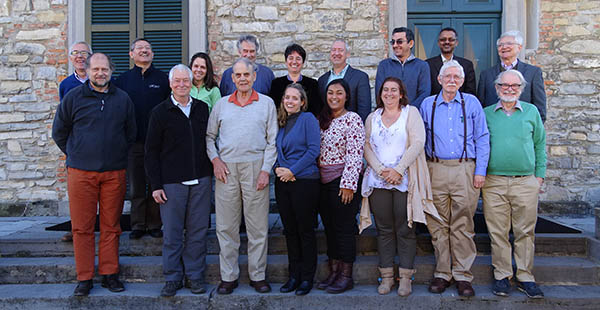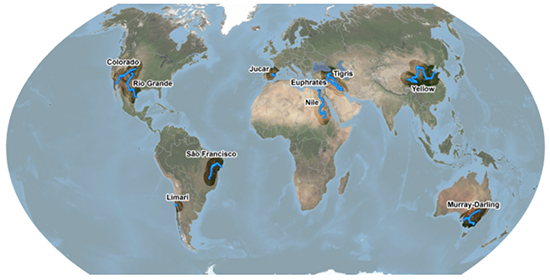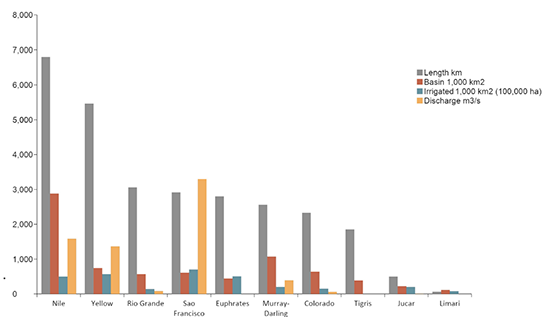By Jurgen Schmandt and George Ward
A system—natural or social—is resilient if it can recover from illness, change, or misfortune. A system is sustainable if it can function successfully after natural or social conditions have changed. The two terms have similar meanings. We can say: "A system is sustainable if it is resilient," or "A resilient system is sustainable." In the work reported here, we focus on the sustainability of engineered hydrological systems in arid environments—the challenges they face and how to protect and restore their sustainability.
| Resiliency Toolkit |
| Full Report (University of Texas Libraries) |
Twenty years ago, we convened a team of Mexican and U.S. experts to assess the future of the Lower Rio Grande (Figure 1), the 1,000 kilometer-long river segment on the U.S.-Mexico border, which supports intensive irrigated agriculture.[1] We found:
Major changes in laws, technology, and management are needed to cope with a predicted 30 percent loss of available water by 2030. The main reasons for water loss are:
- Sedimentation, which reduces the storage volume of reservoirs
- Climate change, which lessens rainfall and increases evaporation
- Outdated irrigation technologies, which use too much water
- Broken distribution systems, which cause massive water losses
Figure 1: Hydrological and impact region in the Lower Rio Grande
To cope with these challenges, we recommended that irrigation districts and farmers, the key actors in the impact region, adopt less water-intensive irrigation technologies and shift to less water-demanding crops. This would maintain economic sustainability. Environmental sustainability, on the other hand, would require additional actions.
In 2014, with funding from the Mitchell Foundation, we convened a workshop in Austin to find out whether other rivers worldwide face similar problems. Experts from different continents attended, reported on the challenges faced in their river basins, and expressed interest in joining an international project to define appropriate response strategies.
Major changes in laws, technology, and management are needed to cope with a predicted 30 percent loss of available water by 2030.
The resulting project, Sustainability of Engineered Rivers in Arid Lands—SERIDAS, brought together an expert for each of 10 rivers, as well as specialists studying key factors that impact river hydrology. The name SERIDAS is inspired by ARIDAS, an earlier project which studied the devastating impacts of droughts in Northeast Brazil. Antonio Magalhães directed ARIDAS. Schmandt participated in his project and Magalhães became a founding member of SERIDAS.
The SERIDAS team met for additional workshops in Germany, supported by the Volkswagen Foundation, and Italy, supported by the Rockefeller Foundation. Two policy research projects at the LBJ School also contributed to the project.[2] We published preliminary results in 2017.[3] In June 2020, we submitted a 19-chapter manuscript to Cambridge University Press. We expect the book to be published in 2021.[4] In the following pages we summarize our findings and recommendations.
"We asked whether ten rivers in arid lands, all home of intensive irrigated agriculture, can provide a sustainable water supply in light of massive challenges, such as climate change, reservoir sedimentation and population growth. We recommend concrete steps that river managers should take to provide a dependable water yield that will maintain or restore economic and ecological sustainability in their basins." —Jurgen Schmandt
The rivers included in the project are Nile, Euphrates-Tigris, Yellow, Murray-Darling, São Francisco, Limari, Colorado, Rio Grande, and Jucar (Figure 2). They are representative of irrigation-intensive rivers worldwide (Figure 3). According to the UN Food and Agriculture Organization irrigation from rivers and aquifers accounts for 40 percent of global crop production.[5]
The physical systems of the 10 rivers share important characteristics: Mountainous headwaters (Himalaya, Andes, Rocky Mountains, etc.) provide reliable river flow from glaciers, snowpack, or rainfall. Hundreds of kilometers downstream the local climate is arid or semi-arid, but the soil is fertile as a result of millennia of sediment accumulation from annual spring floods. Irrigated agriculture has long taken advantage of these conditions, in the process giving birth to ancient civilizations—Mesopotamia, Egypt, China, and the Americas—that flourished over thousands of years.
Over the course of the last century, large-scale engineering enhanced this age-old system. Dams, bypass canals, and distribution channels were built to generate electricity, increase food production, control flooding, and supply water to riverine cities. The first engineered dam, completed in 1902, was built on the Nile. This was followed by two dams on the Rio Grande, opened in 1914 and 1916. Since then, all of the SERIDAS rivers followed suit, building one or several modern reservoirs.
This brought multiple benefits to farmers, cities, and the world. Yet engineered rivers in arid lands face serious challenges. Climate change reduces the timing and volume of snowpack. Climate variability increases the frequency and severity of droughts. Higher temperatures increase water evaporation. Fertile sediment no longer reaches agricultural land. Instead, siltation reduces the storage volume of reservoirs. Chemical fertilizers and urban runoff impair water quality. Overwatering increases soil salinity. Native species suffer from reduced river flow and modifications in the river hydrograph.
Figure 2: The SERIDAS Rivers
The best response to these challenges requires changes in water management. Managers, using the longest period of record available, should determine how engineered rivers in arid regions have met social and environmental needs during periods of low river flow or drought. This dependable yield—a mathematical construct based on the constant volume of withdrawn water that can be met without failure—serves as the single most important management tool for controlling reservoir performance and is often used as a basis for allocation of water from a reservoir system.[6] It should be carefully monitored and recalculated whenever natural or social conditions in the basin reduce water supply or increase water use. Based on the concept of dependable yield we propose this action plan for protecting or restoring the sustainability of reservoir-dominated rivers in arid lands:[7]
Figure 3: Irrigation-Intensive Rivers Worldwide
- Water managers determine that nature's water supply, averaged over the period of the most severe drought experienced in the historical record, delivers a dependable yield sufficient to meet human and ecological needs in the basin.
- If this is not the case, water managers and users proactively search for ways to use water more efficiently.
- Whenever observed or projected changes in the natural system or human actions modify river flow, the dependable yield is redetermined, and water managers, after consultation with water stakeholders, adjust existing rules for water allocation and water use to match the new level of dependable yield.
- Further adjustments are made to maintain/restore an ecologically prudent level of in-stream flow.
We conclude with three sobering comments to remind us of the big obstacles that stand in the way of meeting these sustainability goals:
Management practices. Each of our four recommendations calls for a departure from the usual management practices in most river basins. We invite river managers to adjust their views and procedures so that sustainability becomes their principle goal.
Conjunctive management. Sustainable water management requires a consideration of the connections between river water and groundwater. Existing law in some river regions, for example the Texas part of the Rio Grande basin, makes this goal difficult to reach. We urge movement toward conjunctive management of surface and groundwater.
Water conflicts. Where water becomes the core of, the trigger to, and a weapon in active conflict, the goal of sustainable water supply and demand is unattainable. For example, sub-state level conflicts and illegal control of water resources and water infrastructure deprive people from access to sufficient clean water, energy, and food resources in the Euphrates-Tigris region. The lack of water undermines the search for sustainable development and causes agricultural, economic, and political decline. Sustainability in a river basin requires stability as well as participatory, transparent, inclusive, and accountable governance structures.
Sustainable water management requires a consideration of the connections between river water and groundwater.
Only when these issues are addressed can rivers cope with the looming problems of water scarcity, climate change and variation, reservoir sedimentation, population growth, economic losses, food security, and ecological damage.
The SERIDAS project did not address the impact of the corona virus on water resources, but a European study suggests the following connections:
- Conventional drinking water treatment should be effective, via common disinfectants used in the Water Sector (which already target viruses).
- Conventional wastewater treatment is likely not fully effective, since chemical disinfection, like chlorination or ultraviolet light, is necessary to eliminate viruses.
- Presence/survival of viruses in surface waters is moderate to low because sunlight, oxidative chemicals, and predation by microorganisms threaten the survival of viruses in the natural state. But treatment is recommended for drinking water.
Article: How to treat the coronavirus in the water cycle?
Jurgen Schmandt is professor emeritus at the LBJ School of Public Affairs, University of Texas, Austin. He simultaneously served as director of the Mitchell Center for Global Change, Houston Advanced Research Center. George Ward is retired from the University of Texas Center for Water and the Environment, where he served as Associate Director and continues to perform research on the mechanics of watercourses.
[1] Schmandt, J., Aguilera-Barajas, I., Mathis, M., Armstrong, N., Chapa-Almena, L., Contreras-Balderas, S., Edwards, R., Hazleton, J., Navar-Chaidez, J., Vogel, E., & Ward, G. (2000). Water and sustainable development in the binational Lower Rio Grande/Río Bravo Basin. Final Report to EPA/NSF STAR program (Grant No. R 824799-01-0), Houston Advanced Research Center, The Woodlands, TX.
[2] A. Kibaroglu, J, Schmandt and 14 graduate students (2016), Sustainability of Engineered Rivers in Arid Lands: Euphrates-Tigris and Rio Grande/Bravo. Lyndon B. Johnson School of Public Affairs, Policy Research Project 190.
J. Schmandt, C. Stolp and 12 graduate students (2018), Sustainable River Management on the U.S./Mexico Border; Recommendations for the Paso del Norte. Lyndon B. Johnson School of Public Affairs, Policy Research Project Report 202.
[3] A. Kibaroglu, J. Schmandt and G. Ward (2017), Engineered rivers in arid lands: searching for sustainability in theory and practice. Water International, Volume 42, Number 3.
[4] A. Kibaraglu and J. Schmandt, ed., with assistance by LBJ students R. Buono and S. Thomas (forthcoming), Sustainability of Engineered Rivers in Arid Lands: Challenge and Response. Cambridge University Press, UNESCO Hydrology Series, New York.
[5] Alexandratos, N. and Bruinsma, J. (2013). World Agriculture Towards 2030/2050: The 2012 revision, ESA Working Paper No. 12-03, Rome: FAO.
[6] Linsley, R. and Franzini, J. (1964). Water Resources Engineering, New York: McGraw-Hill Book Co.
[7] Schmandt, J., G. North and G. Ward), "How Sustainable are Engineered Rivers in Arid Lands?" (2013), J. sustain.dev. energy water environ. syst., 1(2), pp 78-93, DOI: http://dx.doi.org/10.13044/j.sdewes.2013.01.0006.






